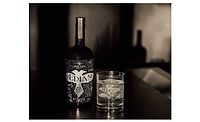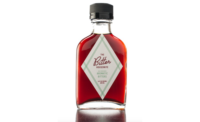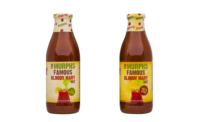![]()
The new Look of Organic
by Sarah Theodore
Organics have come a long way from the image of Birkenstock-wearing
hippies and local food co-ops. Once the province of environmentalists and “health
nuts”, today’s organic companies are sophisticated product developers and savvy
marketers, and many of them are decidedly mainstream.
The organic food industry was worth $10.4 billion in 2003, with
beverages representing 15 percent of organic sales, according to the Organic
Trade Association. The market for organic food has grown 17 to 21 percent each
year since 1997, compared with total food sales, which have grown 2 to 4 percent
per year.
And while natural food stores such as Whole Foods
Market, Wild Oats and Trader Joe’s are leading the trend, more than
40 percent of organic sales last year were through supermarkets, grocery
stores, mass merchandisers and club stores.
So has tree-hugging suddenly become chic or are there
other factors at work? A little bit of both,
according to experts. Most organic companies are still motivated by
concerns for the environment, but as far as consumers are concerned, the
biggest driver of organics is the desire for healthful products. In a way,
it seems the alternative beverage boom of the past decade has segued into
an organics boom.
“Consumer surveys say the reason people list
most often for buying organic products is health reasons,” says Holly
Givens, spokesperson for the Organic Trade Association. “But among
many consumers, it also matches their value systems.”
|
Seth Goldman, co-founder and “TeaEO” at
Honest Tea, Bethesda, Md., says the mindset has shifted during the past
decade. During the early ’90s, the environment was cited most often
as a reason for choosing organic, with health reasons a distant concern. By
2000, that had flipped, with the environment taking a back seat in the
buying decision.
“When you’re at the shelf and it’s a
choice between saving the rain-forest and it costs 30 cents more, you might
say ‘Today I’m going to not worry about the rainforest and
I’m going to buy something cheaper’,” Goldman says.
“Skip ahead to 2000, and someone says ‘Am I going to buy
something that’s good for me or am I going to save 30
cents?’… I think health is a much stronger driver of a
decision.”
“The other big trend is that organics are
becoming a lot more palatable and a lot more professionally made,” he
continues. “Organic produce 10 years ago was mealy and wormy and
didn’t look as fresh. The supply chain wasn’t there, the
distribution chain wasn’t there and from a marketing perspective,
there weren’t a lot of brands out there.”
But the brands have arrived, from organic companies
such as Goldman’s and from conventional companies such as Campbell
Soup Co., which last year introduced Campbell’s Organic Tomato Juice,
and Cadbury Beverages, which recently rolled
out an organic line of Nantucket Nectars juices. According to Productscan
Online, there were 133 new organic beverages introduced last year, and 51
so far in 2004.
Seal of approval
Most of the new organic beverages prominently feature
a green and white USDA Organic seal. In October 2002, the U.S. Department
of Argiculture for the first time established
national organic standards. Previously, certification was voluntary
and standards varied depending on the certifying body.
The USDA implemented four categories of organic food
content, two of which are allowed to use the seal. Products that are made
from 100 percent organic ingredients, and products that have at least 95
percent organic content by weight, excluding water and salt, can carry the
seal. Other designations that are not allowed to use the seal but are able
to mention organic content on packaging are products made with at least 70
percent organic content, which may use the phrase “Made with
Organic” followed by the specific organic ingredients; and those with
less than 70 percent organic content, which may identify organic
ingredients only on the ingredient panel.
It’s not often that businesses welcome
government regulation, but organic companies seem to have embraced the
national standards and many feel the USDA seal adds validity to the
category.
“It’s a very good program. The federal
government has gotten rid of the snake oil in the business,” says Jon
Corriveau, president of Glacier Water Co., Fall City, Wash., which recently
certified its Tahoma sparkling waters with organic flavor essence.
“They put us through a lot to get this certification, which is good
for the consumer.”
Corriveau’s product is sparkling glacier water
sourced from Mt. Ranier. It’s been available for nine years, but
Corriveau says it’s taken off since he switched to an organic essence
formulation. Water itself cannot be considered organic, but the company
worked with an ingredient supplier to find organic essence that could be
used in the product.
“I wanted to be the first organic in this
category,” says Corriveau. “I wanted it to be organic because
of the shelf differentiation with my competitors and because I care deeply
about what goes into the product. Once the government took over
[certification] I dove in. I said the USDA organic symbol is going to give
me clout.”
The Healthy Beverage Co., Newton, Pa., partnered with
the Lion Brewery in Wilkes-Barre, Pa., to
manufacture its Steaz organic, green tea-based soft drinks (see story on
page 38). The brewer had produced micro-brewed sodas in addition to beer,
and agreed to be certified to produce Steaz.
“We spent six months working with Quality
Assurance International and got the plant changed over to be compliant with
the new rules,” says Eric Schnell, co-founder of the Healthy Beverage
Co. “They’re getting tremendous press and other companies that
are looking to pack organic drinks are looking to them now. It’s been
a win-win.”
Honest Tea’s Goldman says the logo has helped
“brand” organic, making it recognizable and easy to understand
across a number of categories.
“We see beverages as a great entry-level product
to try organics,” he says. “Our products are getting into
convenience channels and food channels, and for a lot of people we’ll
be the first organic product they’ll try. A lot of that is due to
this logo.”
Luxury goods
Another big change for the organics industry is that
their products are now seen as high-end alternatives to conventional
products. Organics have always been more expensive than other products, but
they often didn’t look or taste as good. Today’s consumers
expect high quality along with the higher price.
“Organic is trying to position itself as
gourmet,” says Matt McLean, chief executive officer at Uncle
Matt’s Organic Inc., Clermont, Fla. “At Uncle Matt’s, we
strive to make it the gourmet orange juice. We’re a little higher
sugar, a little smoother, a little sweeter than the majority of our
competitors, so we do have a taste difference.”
McLean, who recently announced new distribution in
Canada for Uncle Matt’s juices, says there is still work to be done
to educate consumers about organics.
“There’s still a lot of confusion over
‘organic’, ‘natural’ and
‘fresh’,” he says. “A lot of people don’t
know organic is grown differently. What resonates in their mind is that
organic is synonymous with fresh. But that’s not a bad thing because
people think fresh is better, and they think fresh is gourmet. We’ll
take that for now and once they pick up our products, we can educate them
that organic has a lot of environmental benefits and potential health
benefits.”
Barney Feinblum, who has a long history in organic
products, including serving as chief executive officer at both Celestial
Seasonings and Horizon Organic Dairy, and now as president of Organic
Vintners, Boulder, Colo., says high quality might become the price of entry
for organic companies.
“Years ago, I made the comment that organic doesn’t have to look stepped on. You
don’t have to have the worm holes in the apple. Now it’s become
lush and delicious, and now people view organic as better tasting,”
he says. “It’s hard to get people to pay a premium for a
product they think is inferior. You know you’re going to pay a premium if you’re organic, so you better deliver a
superior taste.”
Organic wine, he says, is one category that had to
fight a quality image. To be considered organic in the United States, wine
cannot contain added sulfites, which most winemakers consider essential to
the production process. Therefore, many products, such as those carried by
Organic Vintners, are instead labeled as “made from organically grown
grapes”.
“A lot of people think that organic wines are
just the U.S. definition, which is no-sulfite-added wines,” he says. “That’s a uniquely American concept
that I think actually hurt the development of the organic wine category
because initially those wines weren’t any good. Our wines are
made with organic grapes. They are low in sulfites, but sulfites have been
added.”
A quality image is also helping organic products make
headway in the foodservice segment. Natural and organic items are a
“potential emerging opportunity to increase profits,” reports
the National Restaurant Association, and according to its research,
43 percent of fine dining restaurants already offer organic items.
Honest Tea is forging a place in the foodservice
industry, with distribution through non-organic restaurants such as
Noodles, Le Madeleine and Marriott, and it’s about to become
the bottled tea of new Independence Airline. In addition, the company is
coming out with a new hot-fill PET package that will make it easier to get
into schools.
“It’s an exciting package and something
that we think is going to further extend the visibility of organic
products,” says Goldman. “We’ve got a lot of interest
from school systems, but one of the challenges we’ve had is that
we’re in glass. It’s a nice example of how organics is reaching
out to places it’s never been.”
The Organic Trade Association’s Givens says we can expect organics
to continue to pop up in even more unexpected places. “The growth [in the organics
industry] has brought with it a lot of new products. Whether you want something
on the gourmet end of the spectrum or a basic, everyday family meal, there is
something out there.”
‘Organic for Everyone’
Among the more mainstream companies getting into organics is
Cadbury Beverages with its new line of Nantucket Nectars organic juices. But
Chris Testa, vice president, Nantucket Nectars, says organic was just the next
logical step for the brand, which has carried a high-end image since its inception.
“We’ve always had high-quality juice, whether it’s using cane
sugar, not-from-concentrate or 100 percent juice,” Testa says. “We said, ‘if
we’re going to be dedicated to quality juice, and consumers are now identifying
organic as quality juice, we’ve got to go out there and provide one’.”
The company launched juices in a few different
textures and flavors — some of the juices are thick and can be
used as meal replacements, others are 100 percent juice and others are
meant to be more refreshing.
“Organic shouldn’t be pigeonholed into these big, thick, expensive
drinks,” says Testa. “We wanted to make it appealing to the broad palate, so
we offered a variety.”
The organic line is distributed through many mainstream retail channels, including convenience stores, and the company chose a tongue-in-cheek approach to marketing, under the umbrella slogan “Organic for Everyone.” Billboard ads tell consumers Nantucket Nectars is a “Less Crunchy” organic.
The organic line is distributed through many mainstream retail channels, including convenience stores, and the company chose a tongue-in-cheek approach to marketing, under the umbrella slogan “Organic for Everyone.” Billboard ads tell consumers Nantucket Nectars is a “Less Crunchy” organic.
“It’s a healthy product, but it
doesn’t require a lifestyle commitment to
drink it,” says Testa. “In our campaign, we bring some levity and say it’s OK if you drink this with a corn dog.”
| Organic food channel distribution 2003 | ||
| Channel | Sales($Mil) | |
| Mass-market grocery | 3,868 | |
| NF grocery chain | 2,011 | |
| NF independent grocery | 2,932 | |
| Mass merch | 367 | |
| Club | 264 | |
| Other | 82 | |
| Food service | 254 | |
| Export | 165 | |
| Farmer’s market | 400 | |
| Boutique/specialty | 26 | |
| Internet/mail order | 12 | |
| Organic food total | 10,381 | |
| Organic food category share 2003 | ||
| Organic food categories | Sales ($Mil) |
% Growth 2003 |
| Dairy | 1,385 | +20.3% |
| Bread & grains | 966 | +22.9% |
| Beverages | 1,581 | +19.3% |
| Fruit & vegetables | 4,336 | +19.9% |
| Snack foods | 484 | +29.6% |
| Packaged/Prepared foods | 1,326 | +16.0% |
| Sauces/Condiments | 229 | +23.5% |
| Meat/Fish/Poultry | 75 | +77.8% |
| Total organicconsumer food sales | 10,382 | +20.4% |



